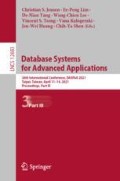Abstract
Explainable recommendation is attracting more and more attention in both industry and research communities. While some existing models utilize reviews for improving the performance of recommender systems, most of them assume that user’s preference is static and each review’s importance is user-independent. However, it is intuitive that user’s preference is always dynamically changing and reviews from similar users should be given more importance as they share similar tastes. Moreover, they achieve model explainability at either feature level that is too concise or review level that is too redundant. To deal with these problems, we propose a Personalized Dynamic Knowledge-aware Recommender (PDKR) for dynamic user modeling and personalized item modeling. In particular, we model user’s preference with defined entities and relations in sequential knowledge graphs and capture its dynamics with a novel interval-aware Gated Recurrent Unit (GRU). Furthermore, by leveraging self-attention mechanism, we can not only learn each review’s user-specific importance, but also provide tailored explanations for each user at both feature level and review level. We conduct extensive experiments on three benchmark datasets from Amazon and Yelp and the results show that PDKR outperforms all the state-of-the-art recommendation approaches in rating prediction task while providing more effective explanations simultaneously.
Access this chapter
Tax calculation will be finalised at checkout
Purchases are for personal use only
Notes
- 1.
The sentiment polarity value should have been 1 (positive) or −1 (negative). We modify the negative value -1 to 0.5, which can be seen as how well the item performs on the feature.
- 2.
For simplicity, the label for discriminating different users and sequences is omitted.
- 3.
- 4.
References
Bilgic, M., Mooney, R.J.: Explaining recommendations: satisfaction vs. promotion. In: Beyond Personalization Workshop, IUI, vol. 5, p. 153 (2005)
Bordes, A., Usunier, N., Garcia-Duran, A., Weston, J., Yakhnenko, O.: Translating embeddings for modeling multi-relational data. In: NIPS, pp. 2787–2795 (2013)
Chen, C., Zhang, M., Liu, Y., Ma, S.: Neural attentional rating regression with review-level explanations. In: WWW, pp. 1583–1592 (2018)
Chen, X., Qin, Z., Zhang, Y., Xu, T.: Learning to rank features for recommendation over multiple categories. In: SIGIR, pp. 305–314 (2016)
Chen, X., Zhang, Y., Qin, Z.: Dynamic explainable recommendation based on neural attentive models. In: AAAI, vol. 33, pp. 53–60 (2019)
Cho, K., et al.: Learning phrase representations using RNN encoder-decoder for statistical machine translation. arXiv preprint arXiv:1406.1078 (2014)
Cramer, H., et al.: The effects of transparency on trust in and acceptance of a content-based art recommender. User Model. User-Adap. Inter. 18(5), 455 (2008). https://doi.org/10.1007/s11257-008-9051-3
Herlocker, J.L., Konstan, J.A., Riedl, J.: Explaining collaborative filtering recommendations. In: CSCW, pp. 241–250 (2000)
Koren, Y., Bell, R., Volinsky, C.: Matrix factorization techniques for recommender systems. Computer 42(8), 30–37 (2009)
Lu, Y., Castellanos, M., Dayal, U., Zhai, C.: Automatic construction of a context-aware sentiment lexicon: an optimization approach. In: WWW, pp. 347–356 (2011)
McAuley, J., Leskovec, J.: Hidden factors and hidden topics: understanding rating dimensions with review text. In: RecSys, pp. 165–172 (2013)
Mnih, A., Salakhutdinov, R.R.: Probabilistic matrix factorization. In: NIPS, pp. 1257–1264 (2008)
Nathani, D., Chauhan, J., Sharma, C., Kaul, M.: Learning attention-based embeddings for relation prediction in knowledge graphs. arXiv preprint arXiv:1906.01195 (2019)
Seo, S., Huang, J., Yang, H., Liu, Y.: Interpretable convolutional neural networks with dual local and global attention for review rating prediction. In: RecSys, pp. 297–305 (2017)
Tan, Y., Zhang, M., Liu, Y., Ma, S.: Rating-boosted latent topics: understanding users and items with ratings and reviews. In: IJCAI, vol. 16, pp. 2640–2646 (2016)
Tintarev, N., Masthoff, J.: A survey of explanations in recommender systems. In: ICDE, pp. 801–810 (2007)
Tintarev, N., Masthoff, J.: Designing and evaluating explanations for recommender systems. In: Ricci, F., Rokach, L., Shapira, B., Kantor, P.B. (eds.) Recommender Systems Handbook, pp. 479–510. Springer, Boston, MA (2011). https://doi.org/10.1007/978-0-387-85820-3_15
Yu, X., et al.: Personalized entity recommendation: a heterogeneous information network approach. In: WSDM, pp. 283–292 (2014)
Zhang, F., Yuan, N.J., Lian, D., Xie, X., Ma, W.Y.: Collaborative knowledge base embedding for recommender systems. In: SIGKDD, pp. 353–362 (2016)
Zhang, Y., Chen, X.: Explainable recommendation: a survey and new perspectives. arXiv preprint arXiv:1804.11192 (2018)
Zhang, Y., Lai, G., Zhang, M., Zhang, Y., Liu, Y., Ma, S.: Explicit factor models for explainable recommendation based on phrase-level sentiment analysis. In: SIGIR, pp. 83–92 (2014)
Zhang, Y., Zhang, H., Zhang, M., Liu, Y., Ma, S.: Do users rate or review? Boost phrase-level sentiment labeling with review-level sentiment classification. In: SIGIR, pp. 1027–1030 (2014)
Zheng, L., Noroozi, V., Yu, P.S.: Joint deep modeling of users and items using reviews for recommendation. In: WSDM, pp. 425–434 (2017)
Acknowledgements
This work is supported by NSFC (No. 61972069, 61836007, 61832017) and Sichuan Science and Technology Program under Grant 2020JDTD0007.
Author information
Authors and Affiliations
Corresponding author
Editor information
Editors and Affiliations
Rights and permissions
Copyright information
© 2021 Springer Nature Switzerland AG
About this paper
Cite this paper
Sun, H., Wu, Z., Cui, Y., Deng, L., Zhao, Y., Zheng, K. (2021). Personalized Dynamic Knowledge-Aware Recommendation with Hybrid Explanations. In: Jensen, C.S., et al. Database Systems for Advanced Applications. DASFAA 2021. Lecture Notes in Computer Science(), vol 12683. Springer, Cham. https://doi.org/10.1007/978-3-030-73200-4_10
Download citation
DOI: https://doi.org/10.1007/978-3-030-73200-4_10
Published:
Publisher Name: Springer, Cham
Print ISBN: 978-3-030-73199-1
Online ISBN: 978-3-030-73200-4
eBook Packages: Computer ScienceComputer Science (R0)

